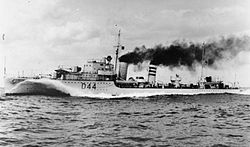HMS Imogen (D44)
|
||||||||||||||||||||||
|
||||||||||||||||||||||
|
||||||||||||||||||||||
|
||||||||||||||||||||||
HMS Imogen (D44) was a destroyer of the eight destroyers and a flotilla commander comprising I-Class of the British Royal Navy . During the Second World War , the destroyer was awarded two Battle Honors (Atlantic 1939, North Sea 1940).
The Imogen was lost on July 16, 1940. In thick fog off the Pentland Firth , the light cruiser HMS Glasgow rammed the destroyer, which caught fire and sank badly damaged.
History of the ship
The Imogen was one of two new I-class destroyers that were ordered from Hawthorn in Hebburn near Newcastle on October 30, 1935 . For the shipyard it was the fourth order for the construction of a destroyer pair for the now eighth class of standard destroyers. The keel of the new building with construction number 604 took place on January 18, 1936 and the launch on December 30 of that year. On June 2, 1937, the destroyer was accepted into the service of the Royal Navy as the sixth ship of the Royal Navy named Imogen .
Mission history
The destroyer was assigned with its sister ships to the "3rd Destroyer Flotilla" in the Mediterranean Fleet , where they replaced the A-class destroyers . The operations of the flotilla after the outbreak of the Spanish Civil War included participation in the so-called neutrality patrols off the Spanish coast in the western Mediterranean in order to protect British interests and prevent arms deliveries to the warring parties.
War missions
On September 3, 1939, the day the British entered the war, the Imogen arrived in Malta after a routine overhaul from Great Britain to resume service with the “3rd Destroyer Flotilla”. The flotilla was ordered back from the Mediterranean to the waters around the British Isles . During an escort operation in the south-western access routes to the British Isles, the Imogen succeeded on October 12, 1939, together with the sister ship Ilex, south-west of Ireland, to sink the German submarine U 42 . The 17 survivors of the submarine were picked up by the Imogen . In December 1939 the destroyer moved to the Home Fleet at Scapa Flow .
In 1940 the destroyer was initially used to cover convoys to Norway . On February 25, the U 63 was sunk near the Shetlands together with the flotilla leader Inglefield and the destroyer Escort . This time the destroyer rescued 24 castaways from the sunk submarine. Subsequently, the Imogen was given the task of securing a mine-laying operation in the coastal waters of Norway, which was still neutral at the time, as part of Operation Wilfred . However, the mission was then canceled due to the approaching German landing in Norway ( company Weser Exercise ). In the following weeks, the destroyer secured heavy units of the Navy and transports off Norway, including the transport of Norwegian troops from Northern Norway to the battle areas with the German invaders.
The end of the destroyer
After the end of the mission in Norway in early June 1940, the destroyer remained with the Home Fleet. During a maneuver on July 16, 1940 in thick fog off the Pentland Firth near Duncansby Head, the Imogen was lost when the cruiser Glasgow rammed the destroyer. The Imogen caught fire and was so badly damaged that the ship could not be brought in, but had to be abandoned. The Glasgow was able to accommodate 135 castaways when the Imogen sank to 58 ° 34 ′ N , 2 ° 54 ′ W19 of the destroyer's men lost their lives in the collision.
Individual evidence
- ^ Rohwer: Sea War. 10-19 October 1939, North Atlantic
- ↑ Rohwer, 18. – 25. February 1940, North Sea
- ↑ Rohwer, 5. – 8. April 1940, Norway
literature
- Maurice Cocker: Destroyers of the Royal Navy, 1893-1981. Ian Allen, 1983, ISBN 0-7110-1075-7
- John English: Amazon to Ivanhoe: British Standard Destroyers of the 1930s. World Ship Society, Kendal 1993, ISBN 0-905617-64-9 .
- Norman Friedman: British Destroyers: From Earliest Days to the Second World War. Seaforth Publishing, Barnsley 2009, ISBN 978-1-84832-049-9 .
- HT Lenton: Warships of the British and Commonwealth Navies. Ian Allan, 1969,
- Antony Preston: Destroyers. Hamlyn, ISBN 0-60032955-0 .
- Jürgen Rohwer , Gerhard Hümmelchen : Chronicle of the naval war 1939-1945. Manfred Pawlak Verlagsgesellschaft, Herrsching 1968, ISBN 3-88199-0097 .
- MJ Whitley: Destroyers of World War 2nd Naval Institute Press, Annapolis 1988, ISBN 0-87021-326-1 .
